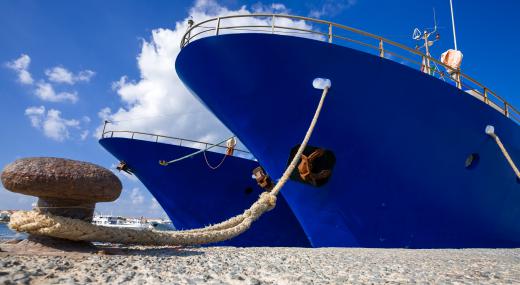A heaving line is a lightweight line which is used on board ship to establish a connection with people in another ship, people on the shore, or shipmates who have gone overboard. These lightweight ropes are typically weighted at one end, classically with a monkey's fist knot, and they are very easy to throw across long distances. Once the line has been tossed, one end of it can be attached to a heavier rope or object.
The advantage to a heaving line is that it is very easy to throw, and less dangerous for someone on the other end of the line. For example, when a ship docks, it is attached to the dock with heavy hawsers which keep it from moving. These hawsers could be extremely dangerous if they were just hurled from the ship to workers on the docks; instead, a heaving line is thrown and caught by a dock workers, and then a hawser is attached on the ship, allowing the dock worker to easily pull the hawser to the dock and make it fast.

A heaving line can also be attached to something like a lifesaving buoy and thrown to someone overboard, and these lines are often used to establish contact between two ships. A line may be attached to a tow rope, for example. Most sailors learn to handle these ropes very early in their training, since there are times when being able to throw one quickly and accurately can be vital.
Several companies make specialized heaving lines, which come complete with weights and anti-kinking materials to ensure that they will not snarl while in storage or in active use. It is also perfectly possible to make a heaving line from existing lightweight, strong rope, and it can be useful to know how to do this in a hurry. To make a heaving line, a knot is tied in one end of the line to weight it, or a weight is tied onto the line for people who cannot make a knot of the right weight.
Along with the wide assortment of ropes and lines on a ship, heaving lines are typically checked regularly. When the lines are checked, sailors make sure that they are not knotted, twisted, or kinked, and they confirm that the line is capable of bearing weight. Lines which have started to fray or rot are discarded to ensure that they are not used by accident.
